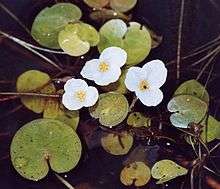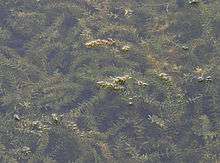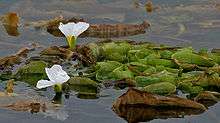Hydrocharitaceae
Hydrocharitaceae is a flowering plant family including 16 known genera with a total of ca 135 known species (Christenhusz & Byng 2016 [2]), that including a number of species of aquatic plant, for instance the tape-grasses, the well known Canadian waterweed and frogbit Hydrocharis morsus-ranae.
| Hydrocharitaceae | |
|---|---|
 | |
| Common frogbit, Hydrocharis morsus-ranae | |
| Scientific classification | |
| Kingdom: | Plantae |
| Clade: | Tracheophytes |
| Clade: | Angiosperms |
| Clade: | Monocots |
| Order: | Alismatales |
| Family: | Hydrocharitaceae Juss.[1] |
| Genera | |
|
See text | |
The family includes both fresh water and marine aquatics. They are found throughout the world in a wide variety of habitats, but are primarily tropical.
Description
The species are annual or perennial, with a creeping monopodial rhizome with the leaves arranged in two vertical rows, or an erect main shoot with roots at the base and spirally arranged or whorled leaves. The leaves are simple and usually found submerged, though they may be found floating or partially emerse. As with many aquatics they can be very variable in shape – from linear to orbicular, with or without a petiole, and with or without a sheathing base.
The flowers are arranged in a forked, spathe-like bract or between two opposite bracts. They are usually irregular, though in some case they may be slightly irregular, and either bisexual or unisexual. The perianth segments are in 1 or 2 series of (2–)3 free segments; the inner series when present are usually showy and petal-like. Stamens 1–numerous, in 1 or more series; the inner ones sometimes sterile. Pollen is globular and free but in the marine genera (Thalassia and Halophila) – the pollen grains are carried in chains, like strings of beads. The ovary is inferior with 2–15 united carpels containing a single locule with numerous ovules on parietal placentas which either protrude nearly to the centre of the ovary or are incompletely developed. Fruits are globular to linear, dry or pulpy, dehiscent or more usually indehiscent and opening by decay of the pericarp. Seeds are normally numerous with straight embryos and no endosperm.
Pollination can be extremely specialised.
The most recent phylogenetic treatment of the family recognizes four subfamilies – Hydrocharitoideae (Hydrocharis, Limnobium), Stratiotoideae (Stratiotes), Anacharioideae (Apalanthe, Appertiella, Blyxa, Egeria, Elodea, Lagarosiphon and Ottelia) and Hydrilloideae (Enhalus, Halophila, Hydrilla, Maidenia, Najas, Nechamandra, Thalassia and Vallisneria).[3]

Uses
Some species have become established ornamental plants, and subsequently serious weeds in the wild (especially Egeria, Elodea and Hydrilla).
Genera
| Kubitzki (ed. 1998[7]) | data.kew[8] | APWeb (mobot.org)[9] | Watson & Dallwitz (delta-intkey)[10] |
|---|---|---|---|
| Hydrocharitaceae | |||
| 1. Ottelia | Ottelia Pers. (including Benedictaea Toledo, Boottia Wall.) (excludes Oligolobos Gagnep.) | Ottelia Persoon (including Benedictaea Toledo, Boottia Wallich, Oligolobos Gagnepain, Xystrolobus Gagnepain) | Ottelia |
| 2. Stratiotes | Stratiotes L. | Stratiotes L. | Stratiotes |
| 3. Hydrocharis | Hydrocharis L. | Hydrocharis L. | Hydrocharis |
| 4. Limnobium | Limnobium Rich. (including Hydromystria G.Mey. | Limnobium Richard (including Hydromystria G. Meyer) | Limnobium |
| 5. Blyxa | Blyxa Noronha ex Thouars (excludes Enhydrias Ridl.) | Blyxa Richard (including Enhydrias Ridley) | Blyxa |
| 6. Apalanthe | Apalanthe Planch. | (in Elodea Michaux) | Apalanthe |
| 7. Egeria | Egeria Planch. | Egeria Planchon | Egeria |
| 8. Elodea | Elodea Michx. (including Anacharis Rich., Udora Nutt.) | Elodea Michaux (including Anacharis Richard, Apalanthe Planchon, Hydora Besser, Philotria Rafinesque, Serpulica Pursh, Udora Nuttall) | Elodea |
| 9. Hydrilla | Hydrilla Rich. | Hydrilla Richard | Hydrilla |
| 10. Appertiella | Appertiella C.D.K.Cook & Triest | Appertiella C. D. K. Cook & Triest | Appertiella |
| 11. Lagarosiphon | Lagarosiphon Harv. | Lagarosiphon Harvey | Lagarosiphon |
| 12. Nechamandra | Nechamandra Planch. | Nechamandra Planchon | Nechamandra |
| 13. Maidenia | Maidenia Rendle | Maidenia Rendle | Maidenia |
| 14. Vallisneria | Vallisneria L. | Vallisneria L. | Vallisneria |
| 15. Enhalus | Enhalus Rich. | Enhalus Richard | Enhalus |
| 16. Thalassia | Thalassia Banks ex C.Koenig | Thalassia C. Koenig | Thalassia |
| 17. Halophila | Halophila Thouars | Halophila Thouars | Halophila |
| (in Najas, Najadaceae) | Najas L. | Najas L. | (in Najas, Najadaceae) |
| (name not found) | Enhydrias Ridl. | (in Blyxa, Hydrocharitaceae) | (name not found) |
| (name not found) | Oligolobos Gagnep. | (in Ottelia, Hydrocharitaceae) | (name not found) |
| Najadaceae | |||
| 1. Najas | (in Najas, Hydrocharitaceae) | (in Najas, Hydrocharitaceae) | Najas |
References
- Angiosperm Phylogeny Group (2009). "An update of the Angiosperm Phylogeny Group classification for the orders and families of flowering plants: APG III". Botanical Journal of the Linnean Society. 161 (2): 105–121. doi:10.1111/j.1095-8339.2009.00996.x. Archived from the original (PDF) on 2017-05-25. Retrieved 2013-06-26.
- Christenhusz, M. J. M.; Byng, J. W. (2016). "The number of known plants species in the world and its annual increase". Phytotaxa. Magnolia Press. 261 (3): 201–217. doi:10.11646/phytotaxa.261.3.1.
- Les DH, DH; Moody, ML; Soros, CL (2006), "A reappraisal of phylogenetic relationships in the monocotyledon family Hydrocharitaceae (Alismatidae)", Aliso, 22: 211–230, doi:10.5642/aliso.20062201.18
- Tanaka, Norio; Setoguchi, Hiroaki; Murata, Jin (1997), "Phylogeny of the family Hydrocharitaceae inferred from rbcL and matK gene sequence data", Journal of Plant Research, 110 (3): 329, doi:10.1007/BF02524931
- Les, DH; Cleland, MA; Waycott, M (1997), "Phylogenetic studies in Alismatidae, II: evolution of marine angiosperms (seagrasses) and hydrophily", Systematic Botany, 22 (3): 443, doi:10.2307/2419820, JSTOR 2419820
- Genera of Hydrocharitaceae, GRIN Taxonomy for Plants
- Kubitzki (ed.) 1998. The families and genera of vascular plants, vol 4, Monocotyledons: Alismatanae and Commelinanae (except Gramineae). Springer-Verlag, Berlin.
- Vascular Plant Families and Genera. List of genera in family HYDROCHARITACEAE (accessed 2016-06-02) http://data.kew.org/cgi-bin/vpfg1992/genlist.pl?HYDROCHARITACEAE
- VASCULAR PLANT FAMILIES and GENERA. List of Genera in HYDROCHARITACEAE. (accessed 2016-06-02) http://www.mobot.org/mobot/research/apweb/genera/hydrocharitaceaegen.html
- Watson & Dallwitz. Hydrocharitaceae. The families of flowering plants. http://delta-intkey.com/angio/www/hydrocha.htm
External links


- . Encyclopædia Britannica. 14 (11th ed.). 1911. p. 112.
